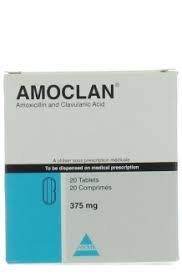
In the realm of medicine, where every discovery is a step towards enhancing human well-being, the evolution of antibiotics stands as a testament to scientific ingenuity. Among the myriad antibiotics that have transformed the landscape of healthcare, Amoclan emerges as a beacon of hope, offering a dual-action approach to combat bacterial infections. In this article, we delve into the depths of Amoclan, exploring its mechanism, applications, and the profound impact it has had on modern medicine.
Unraveling the Mechanism
Amoclan, a combination antibiotic, comprises two potent ingredients: amoxicillin and clavulanic acid. Amoxicillin, a member of the penicillin family, serves as the primary agent targeting bacterial cell walls. It disrupts the synthesis of peptidoglycan, a vital component of bacterial cell walls, ultimately leading to cell lysis and death. However, bacteria have evolved mechanisms to counteract the effects of antibiotics, often rendering them ineffective. This is where clavulanic acid comes into play.
Clavulanic acid acts as a β-lactamase inhibitor, thwarting the efforts of β-lactamase enzymes produced by bacteria. These enzymes are notorious for their ability to deactivate β-lactam antibiotics like amoxicillin, rendering them ineffective against bacterial infections. By inhibiting β-lactamase, clavulanic acid restores the efficacy of amoxicillin, effectively tackling bacterial resistance and enhancing the antibiotic’s potency.
Versatility in Treatment
The versatility of Amoclan lies in its broad spectrum of activity, making it effective against a wide range of bacterial infections. From respiratory tract infections and urinary tract infections to skin and soft tissue infections, Amoclan stands as a formidable weapon against bacterial pathogens. Its ability to penetrate various tissues and reach high concentrations at the site of infection ensures thorough eradication of bacteria, promoting swift recovery and preventing the emergence of resistance.
Furthermore, Amoclan finds utility in the treatment of mixed infections where multiple bacterial species are involved. Its dual-action mechanism addresses the complexities of such infections, ensuring comprehensive coverage and expedited healing. Whether it’s combating community-acquired infections or managing more severe cases in hospital settings, Amoclan remains a cornerstone in the arsenal of healthcare providers worldwide.
Clinical Efficacy and Safety
The clinical efficacy of Amoclan is well-established, supported by a wealth of empirical evidence and real-world experience. Numerous clinical trials and studies have demonstrated its effectiveness in achieving bacterial eradication and clinical cure across various infection types and patient populations. Moreover, its safety profile is favorable, with adverse effects typically being mild and transient.
However, prudent antibiotic stewardship remains imperative to mitigate the risk of antimicrobial resistance and minimize collateral damage to the microbiome. Healthcare professionals must exercise caution in prescribing Amoclan, reserving its use for situations where its benefits outweigh the risks. Additionally, patient education regarding proper antibiotic usage and compliance plays a pivotal role in optimizing treatment outcomes and preserving the efficacy of antibiotics for future generations.
Addressing Challenges and Future Directions
Despite its efficacy and versatility, Amoclan is not without its challenges. The emergence of antibiotic resistance poses a significant threat to its long-term efficacy, necessitating ongoing surveillance and research efforts to identify novel strategies to combat resistance mechanisms. Furthermore, the global burden of infectious diseases, compounded by factors such as population growth, urbanization, and climate change, underscores the importance of continued innovation in antibiotic development and infection control measures.
Looking ahead, the future of Amoclan and other antibiotics hinges on collaborative efforts across disciplines and sectors. From pharmaceutical research and development to public health initiatives and regulatory policies, a concerted approach is essential to safeguard the effectiveness of antibiotics and ensure equitable access to life-saving treatments worldwide. Moreover, investment in alternative approaches such as phage therapy, immunotherapy, and novel drug delivery systems holds promise in addressing the evolving challenges of antimicrobial resistance.
Conclusion
In conclusion, Amoclan stands as a testament to the remarkable progress achieved in the field of antibiotics, offering a dual-action approach to combat bacterial infections and enhance patient outcomes. Its synergistic combination of amoxicillin and clavulanic acid exemplifies the power of innovation in overcoming the challenges posed by antimicrobial resistance. As we navigate the complex landscape of infectious diseases, Amoclan remains a stalwart ally in the fight against bacterial pathogens, embodying the relentless pursuit of healing and the advancement of human health.
